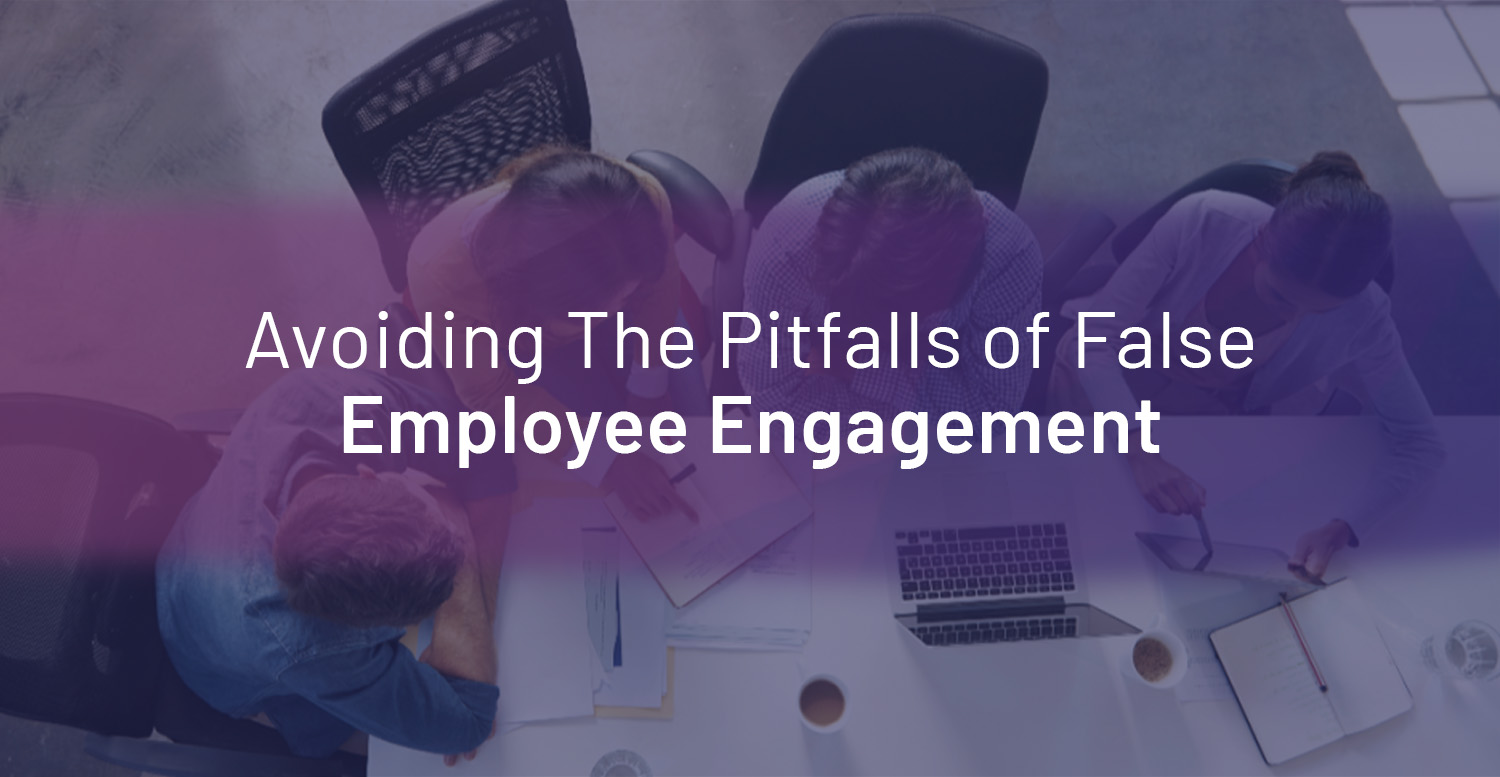
Category: Agile Leadership
Avoiding the Pitfalls of False Employee Engagement
Date of Release: November 5th, 2023
Reading Time: 04 mins

Written by Stephen Otterstrom
![]()
Around the world, employers struggle to increase the level of engagement. At a company that I worked with, engagement was considered an element of a success trifecta, consisting of customer satisfaction, profits, and employee engagement.
As a consultant, I speak with clients across a variety of industries who report they are experiencing an engagement crisis. Low engagement is creating invisible attrition. Staffing stays the same while productivity declines. Even when hiring new employees, finding talent is only half the job, getting them to engage in the other. Universally organizations recognize low engagement as a problem; however, there appears to be no consensus on the solution.
The word “engagement” is emblematic of this challenge. Engagement can be used to describe the loving commitment of two individuals preparing for a lifelong commitment to one another. Alternatively, it is defined as a potentially lethal conflict between two armed forces. Metaphorically speaking, I have seen many organizations attempt to increase their employee engagement in ways that resemble both definitions, at times simultaneously. If we want to improve our employee engagement, we need to first understand and apply the “engage” part of it.
When I was a teenager I understood, “engage” as the word Captain Jean-Luc Picard of the Starship Enterprise would epically utter to cause his starship to leap forward to speeds that warped both space and time.
Similarly, the word “engage” is what can move your organization forward at speeds only conceived of in science fiction. To engage is to immerse and dedicate to a purpose. It is a verb in the truest form. It is not a concept or a result. It is action. It is an energy. If a leader or organization wants to increase engagement, they must apply genuine engaging behaviors and recognize and eliminate false engagement.
The error of engaging through passive efforts
Passive efforts are generally policy-driven. The organization or leader creates a policy and then sits passively waiting for the employee to activate it. The simplest and most common of these is the “Open Door Policy.” I am not advocating against an open-door policy; however, unless the policy is, “My door is always open because I am walking out of my office to proactively engage with employees” you are not increasing engagement with this policy. In a virtual environment, it becomes nothing more than a hollow gesture nestled in a remote corner of your employee handbook.
Another passive effort is to pretend there is no problem at all. Nearly every organization or team that I have consulted on employee engagement has told me their employees are more engaged than their engagement survey indicates. They tell me, that their employees just did not properly understand the questions on the survey. As a training manager, I too was caught up in this nonsensical notion. I attended numerous department meetings and standups where I attempted to convince employees that the question’s true meaning was something different than their plain language definitions. This approach was effective in increasing engagement survey scores but failed to create more engaged teams. It was a classic example of meeting a metric at the detriment of the objective.
This approach is wrong on multiple fronts. I will address two.
First, engagement should not be measured through a single method. If you are looking only at employee survey data, you are seeing only a sliver of the engagement picture. Organizations and teams who use a single methodology approach find that eventual efforts to meet the metric will overpower the efforts to meet the objective. You will have high scores and low engagement.
Second, your employees are smart. They understand the question. However, don’t be surprised if they say they did not when you confront them. The survey was anonymous, but the confrontation was not. Regardless, let’s pretend they did not understand the question in the way you wanted them to. It is backward for you to ask them to understand the question your way. You should be spending your time understanding what the question meant to them and fixing the issue from their perspective, not yours.
The error of Engaging Through Distraction
This error attempts to engage by creating a positive feeling near engagement with the hope that the positive feeling will cause the employee to want to engage. Three common ways this happens are, paying to engage, feeding to engage, and entertaining to engage. Each of these efforts are valuable in their own right; however, they are often misdirected or overused to allow management to make no significant changes to the status quo. It is like attempting to improve the flavor of a cake by just adding more frosting and never looking at the ingredients at the center of the cake.
Paying to engage generally looks like a loyalty reward program at work. The idea is to reward good behavior with an extra something. This type of program can be very effective for helping create the habits you hope to see, however, it is only nominally effective at increasing true employee engagement because the engagement is directed toward a reward rather than the business objective.
Feeding to engage, occurs when managers attempt to create engagement by offering a benefit. I have talked to many managers who were baffled by their low engagement. They told me it should be higher because they were buying pizza every Friday for their team. This could be a great way to express appreciation and could even be a practical way to promote greater productivity because employees are not leaving for lunch, but still fail to offer any real change. It is more frosting and has no substance.
Entertaining to engage generally looks like team building activities. These may be times when the team gets off-site to do something fun. These are valuable experiences and can initiate an engagement opportunity, however, these alone will have little effect because any changes will have to survive the trip back to the office. Generally, a few days after the outing the team is back to business as usual. A successful team building will require frequent and meaningful follow-up if any last change is expected. Fun alone will not engage.
Building an Employee Engagement Foundation
Building stronger employee engagement begins with the recognition that your employees are already engaged, just not with you, your organization, or your team. They are engaged with their passions, their purpose, and their people. Underlying all of these are their personal values.
The anatomy of engagement is relatively simple. On the outside, you observe driven interaction. On the inside is a personal value. The personal value is the “engage” in engagement. This value is like a small nuclear reactor with extreme and almost limitless energy. It is so powerful it induces your employees to act regardless of pay or benefits. The value is more than something they carry with them, it is a key thread woven into their identity as human beings.
Many organizations publish institutional values. The effectiveness of institutionalized values varies greatly depending on how well they are incorporated into daily activities and how closely they coincide with the personal values of your employees. If you want the highest level of engagement set your organizational values aside for a moment and determine what are the personal values that animate and power your employees. Once you know what their values are, the next key is to create as many opportunities as possible to allow them to exercise that value at work. Doing this will require creativity and collaboration. There is no one-size-fits-all approach.
In another article, I hope to address this concept more thoroughly. The core concept is to allow your employees to incorporate their personal core values and mission into what they do every day at work. It is extremely unlikely that it will be a single massive change. Rather a host of smaller alterations to how they currently work. It could be as simple as allowing employees to decorate their workspace with items that allow them self-expression. It may be allowing your purchaser to consider environmental factors when making purchasing decisions and not just price. It may be letting a marketing person put together a campaign where your product is distributed to needy organizations.
The key to success will be first creating an environment where your employees feel free to share their values. Next, your organization needs to have enough flexibility in its processes so your employees can tap into their values when performing their daily tasks. A key element to this step is making the objective of your processes clear so that variations are appropriate. When humans complete a task their value system deems good, the reward center of the brain is activated. This internal validation will keep them coming back and even move the employee beyond engaged and into the territory of loyalty.
Trending Posts
Creating a Culture of Accountability within Your Agile Team
Accountability serves as the vital link connecting tasks to objectives and aligning individuals across an organization.
Last updated on 13th July 2023
The QA Team Should NEVER Find a Bug!
Many companies use metrics to measure the performance of the Sales Team, the Developers, the QA Team, etc.
Last updated on 14th May 2023
Do You Want to Save $50,000 per Developer per Year?
A number of case studies have shown that a typical developer spends 30% to 40% of their time fixing bugs.
Last updated on 11th October 2021
Follow Us

Creating a Culture of Accountability within your Agile Team
Accountability serves as the vital link connecting tasks to objectives and aligning individuals across an organization.

Pytest-BDD vs. Behave
Love it or loath it, Python is the language of choice for most Data Scientists – so if the work is done in Python and you are writing the requirements in Gherkin, what tool should you use to automate testing?

SBE BDD for Data Science
Data Science and Big Data are hot topics, and rightly so – companies can save huge sums, or dramatically increase sales, by analyzing the data that they already collect. Specification by Example is a great partner in this effort.
Be a part of SevenSparx community to enjoy free resources in your inbox!






